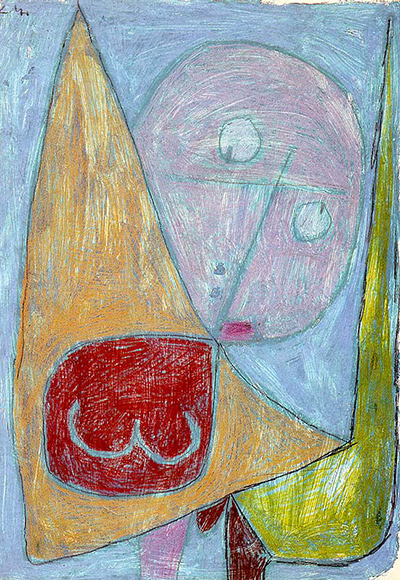Paul Klee was a Swiss artist whose paintings established a creative milestone with his use of colour, form and texture.
This combination brought an individuality to each of Klee’s works, rarely seen in an artist. Not long before his death, Klee painted Angel Still Feminine (1939).
The image is composed of a series of shapes, stark against one another because of Klee’s use of colour. The pink circle with eyes and the green arm suggest a female form, the “angel” of the title.
The orange triangle is a piece of clothing or drapery, while the dark red shape in the foreground painted with a silver “w” is possibly a clutch purse. The shapes are set against a blue background, suggesting the sky or eternity.
On closer inspection, the colours are not solid blocks but composed of tiny strokes or hatches of darker colour laid against paler shades.
At least three shades of blue compose the background. The orange triangle contains hatches of lemon, as does the green arm. This technique gives a liveliness to the entire image, while demonstrating Klee’s knowledge of optics.
He uses a similar technique in Growth of a Nocturnal Plant (1922), where forms of individual colour stack up to create the illusion of flowers emerging from darkness. As in Angel Still Feminine, the forms are hatched with various colours but fool the eye briefly into perceiving one colour.
In Angel Still Feminine, the dark dashes that represent the pupils of the eye are skewed, with one looking up and the other looking down. This gives the face a surprised and disoriented appearance.
This trope is possibly a comment on Klee’s state of mind in 1939; he knew that he was dying. In painting, the eye had always been significant for Klee, and expressed it as “where all paths meet” in his writing. In Senecio (1922), a large pair of eyes stare from a round, multicoloured face. The eyes are slightly skewed, the starting point of the complete disorientation of Angel Still Feminine.




